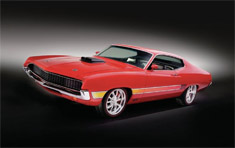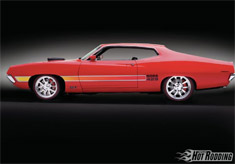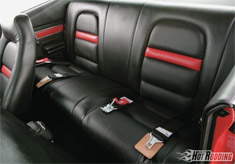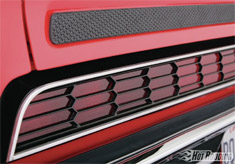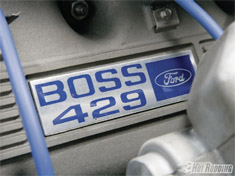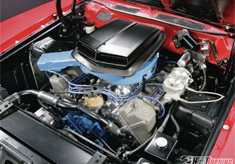1970 Boss Torino GT
Written by Christopher Campbell/ October, 2011
The options checklist is a new car buyer’s chance to mix and match parts and packages to tailor their car to their personality and performance expectations. On modern cars it’s mostly focused on creature comforts and styling with drivetrain options fairly locked in by the chosen model. For example: You want a new Mustang GT, you get the 5.0, but for the blown 5.4, you step up to the GT500.
That wasn’t always the case. Mixing and matching engine choices used to be one of those seminal decisions when placing your order. In 1970, when Ford launched the massively reworked and aggressively styled Torino, there were five engine displacement options: a 250ci sixer, 302ci and 351ci Windsor, 351ci Cleveland, and the big bad 429ci 385 Series. The 429 even had three options of its own: the 429 Thunder Jet rated at 360hp, the 429 Cobra Jet rated at 370hp, and the ultimate 429 Super Cobra Jet rated at 375 hp. The 429 that didn’t make the cut was the legendary Boss. Or did it?
The long accepted assumption was that any gearhead looking for a street-going Boss 429 engine was buying a SportsRoof Mustang. We always thought that was the case as well. Not even seemingly ideal candidates, the ’69 Torino Talladega, for example, were so bestowed; all of those were fitted with 428 Cobra Jet engines. As it turns out, though, there may have been a loophole.
Tim Gilbert pondered those scenarios as well, as he stood, brochure in hand, looking at his newly acquired ’70 Torino GT. He’d always wanted a factory big-block, four-speed ’70 Torino, with all of the unique styling options that the GT package included. Fittingly in our opinion, and probably maddeningly to Torino purists, the car that finally presented itself as the right platform to build his dream after years of searching was a legit J-code 429 CJ car—one of only 412 GTs equipped with a 429 CJ, shaker hood, and a four-speed.
We say fittingly, because it arrived as a solid roller, sans drivetrain. Tim’s original plan was simply to restore the Torino to near-factory spec and enjoy it. However, that single, overlooked line from the brochure gnawed at him. It wasn’t a Cobra, but it was a 429 car. Perhaps it was time someone built the Boss Torino that should have been—simple, near stock, just with a badass semi-Hemi engine. “And then the madness began,” Tim says, with a laugh.
Since none were built, and the matching-numbers hoopla was thrown out the window, the question then became: What should a Boss 429 Torino look like? The brochure specifically stated Cobra only, but Tim definitely wanted to retain the GT’s hideaway headlights, full-length taillights, and plush interior options. With that in mind, Tim enlisted renowned artist Steve Stanford to help him capture something that felt like a uniquely personalized package Ford might have offered for Boss 429-powered Torinos.
That idea and a stack of photos of cars and options he liked was pretty much all Tim had for Stanford, though: "I told him, 'If I knew what I wanted, I wouldn’t be here!'"
With a deceivingly subtle style penned by Stanford in hand, Tim touched base with Eric Thorsen to make the interior a reality. “I liked him from the start when he asked me to send him a copy of the rendering, so he could put it up and just think about it for a while, Tim says. “That’s the guy you want to do your interior!” One man slaved over the interior, but getting the long curves of the Torino’s body back in shape took a minor army in the shape of three shops: GMT Metalworks for the sheetmetal, Dan Fink Metalworks for the mods to make the Boss 429 fit between the fenders, and Lanzini Bodyworks for final paint.
As for the genesis for the whole project—the Boss engine—when Tim first started the build it was before the recent resurgence of boutique power parts, and aftermarket heads weren’t yet available. Pricey vintage ones were few and far between and became a source of expense and delays due to constant cracking during machining. Thankfully, ShotGun Hemi Parts released their revamped new Boss heads, and from there the engine build snowballed as quickly as the rest of the car. Boss engine guru Rick Stanton at Performance Engine Building derailed what he called Tim’s “mild” plans for a 450-550hp 429, or even 494ci Boss. To make good use of heads that flow 475 cfm at .650, Stanton concocted a recipe for 598 inches and a streetable 870 hp. Yes, we said streetable; Stanton intended for it to be driven regularly.
Clearly, things got a little out of hand and the build schedule grew in response as well, but in the end what emerged is perhaps the finest Torino ever built, though much of the details are hidden to the casual observer. Then again, that’s fine with Tim; it’s subtle enough for the Ford purists to appreciate, custom enough for hot rodders to envy, and powerful enough for any gearhead to drool over.
His only complaint? The Torino drives smooth and tight like the Grand Touring muscle car it is, but 870 hp with a torque curve like a tabletop takes some getting used to; it tends to tear the tires loose at pretty much any speed and in any gear. “Well, it is Ferrari red,” Tim says. “Maybe I should take it to Ferrari of Washington, pull up right in front of the showroom next to a new 458 Italia, and ask if someone will show me how to drive it!” Sounds like fun to us, though we’ll bet the Ferrari cognoscenti will be far more intimidated by the bark from the twin tips than Tim ever was.

